Pit chains hint at recent marsquakes on red planet
Oct 29:
Strings of depressions dotting the Martian landscape indicate that seismic activity —
marsquakes — may still be reshaping the surface of the planet. These pit
chains occur along dilational faults, partially filled or open cavities that
served as conduits for past groundwater flow.
 FULL STORY FULL STORY
 |  |

|
 |
Cassini's radar shows Titan's young active surface
Oct 29:
The first radar images of Saturn's moon Titan show a very complex geological
surface that may be relatively young. Previously, Titan's surface was hidden
behind a veil of thick haze.
 FULL STORY FULL STORY
 RADAR IMAGERY RADAR IMAGERY
 |  |

|
 |
Two views of Titan's haze
Oct 28:
Titan's planet-wide stratospheric haze is observed in Cassini's first close encounter
with the shrouded moon. This image shows Titan's night-side backlit by the Sun
after the space probe's closest approach to the moon. The haze layer ringing
the planet is illuminated because the small particles scatter significant sunlight
in the forward direction.
 FULL STORY FULL STORY
 |  |
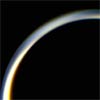
|
 |
Gigantic cosmic corkscrew reveals new details
Oct
28:
Making an extra effort to image a faint, gigantic corkscrew traced by fast protons
and electrons shot out from a mysterious microquasar paid off for a pair of
astrophysicists who gained new insights into the beast's inner workings and
also resolved a longstanding dispute over the object's distance.
 FULL STORY FULL STORY
 |  |

|
 |
Scientists elated by Cassini's Titan observations
Oct
27:
After years of anticipation, the Cassini spacecraft beamed back smog-piercing
close-up images of Saturn's moon Titan late Tuesday, revealing a strange, striated
landscape that both thrilled —
and mystified — planetary scientists.
 FULL STORY FULL STORY
 |  |

|
 |
Stellar survivor from 1572 A.D. supports theory
Oct
27:
An international team of astronomers is announcing today that they have identified
the probable surviving companion star to a titanic supernova explosion witnessed in
the year 1572 by the great Danish astronomer Tycho Brahe and other astronomers of
that era.
 FULL STORY FULL STORY
 |  |

|
 |
Titan up close
Oct
26:
These raw, un-processed images of Saturn's moon Titan were taken by the Cassini
spacecraft and transmitted to Earth on October 26th. The pictures provide the
closest views ever snapped of the hazy moon.
 PICTURE COLLECTION PICTURE COLLECTION
 |  |
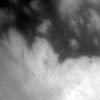
|
 |
Cassini has close encounter with Saturn's moon Titan
Oct
26:
NASA's Cassini spacecraft streaked by Saturn's smoggy moon Titan on Tuesday,
October 26th, targeted to pass within just 750 miles of the planet-sized satellite
to give scientists their first detailed glimpse of a world that, until now,
has been shrouded in mystery. A news conference to discuss the pictures and
data is planned for 1600 GMT (12 noon EDT) Wednesday, 27th.
 FULL STORY FULL STORY
 FLYBY TIMELINE FLYBY TIMELINE
 OUR CASSINI MISSION ARCHIVE OUR CASSINI MISSION ARCHIVE
 |  |
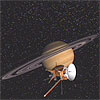
|
 |
Lonely halo raises questions about dark matter
Oct
26:
Dark matter continues to confound astronomers, as NASA's Chandra X-ray Observatory
demonstrated with the detection of an extensive envelope of dark matter around
an isolated elliptical galaxy.
 FULL STORY FULL STORY
 |  |

|
 |
Eyes on Xanadu
Oct 25:
This stunning image taken on Sunday, October 24th, reveals Titan's bright "continent-sized"
terrain known as Xanadu. It was acquired with the narrow angle camera on Cassini
as the craft sped toward its first close encounter with the largest moon of
Saturn.
 FULL STORY FULL STORY
 |  |
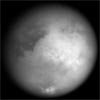
|
 |
Survey finds mysterious new Milky Way companion
Oct
24:
Most of the stars in our Milky Way galaxy lie in a very flat, pinwheel-shaped
disc. Although this disc is prominent in images of galaxies similar to the Milky
Way, there is also a very diffuse spherical "halo" of stars surrounding and
enclosing the discs of such galaxies.
 FULL STORY FULL STORY
 |  |

|
 |
As the world turns, it drags space and time
Oct
24:
An international team of NASA and university researchers has found the first
direct evidence that the Earth is dragging space and time around itself as it
rotates.
 FULL STORY FULL STORY
 |  |

|
 |
New view of the sky
Oct
20:
Astronomers have overcome longstanding technical hurdles to map the sky at little-explored
radio frequencies that may provide a tantalizing look deep into the early universe.
The scientists have released images and data covering half of the sky, and hope
to complete their survey within a year.
 FULL STORY FULL STORY
 |  |

|
 |
I, Robotic Telescope
Oct
20:
The world of astronomy meets the science fiction world of Isaac Asimov's "I,
Robot" with
the commissioning of a new robotic telescope. While it lacks the humanoid qualities
of the movie version, this robot will aid in humanity's quest to understand
the early universe by observing the most distant and powerful explosions known.
 FULL STORY FULL STORY
 |  |

|
 |
Europe's Hipparcos finds rebels with a cause
Oct
20:
A team of European astronomers has discovered that many stars in the vicinity
of the Sun have unusual motions caused by the spiral arms of our galaxy, the
Milky Way. According to this research, based on data from ESA's Hipparcos observatory,
our stellar neighbourhood is the crossroads of streams of stars coming from
several directions.
 FULL STORY FULL STORY
 |  |

|
 |
Astronomers discover planet building is big mess
Oct
18:
Planets are built over a long period of massive collisions between rocky bodies
as big as mountain ranges, astronomers announced Monday, October 19th. New observations
from NASA's Spitzer Space Telescope reveal surprisingly large dust clouds around
several stars. These clouds most likely flared up when rocky, embryonic planets
smashed together.
 FULL STORY FULL STORY
 |  |

|
 |
European probe on track for its Moon encounter
Oct
18:
The ion engine of European Space Agency's SMART-1 probe carried out a continuous
thrust manoeuvre last week in the final major push that will get the spacecraft
to the Moon capture point in mid-November.
 FULL STORY FULL STORY
 |  |

|
 |
Cassini yields new knowledge of Saturn's rings
Oct 17:
Although the probe has only been orbiting the planet since July 1st, data from
the Cassini Plasma Spectrometer has already begun to provide new information
about the curious nature of Saturn's space environment.
 FULL STORY FULL STORY
 |  |
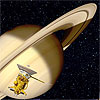
|
 |
Probe preparing to plunge into Titan's atmosphere
Oct
15:
On January 14th, the Huygens probe will plough into the orange atmosphere of
Saturn's moon, Titan, becoming the first spacecraft to attempt to land on a moon
in our solar system since the Soviet Union's Luna 24 touched down on Earth's
moon in 1976.
 FULL STORY FULL STORY
 |  |
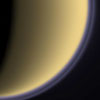
|
 |
Research shows liquid water on Mars briefly
Oct
14:
A Ph.D. student at Virginia Tech has research published this week in Nature that
shows Mars probably had liquid water at some point, but likely for only a short
time, geologically speaking.
 FULL STORY FULL STORY
 |  |

|
 |
U.K. astronomers scan the skies for threat from space
Oct
13:
British astronomers are providing a vital component to the world-wide
effort of identifying and monitoring rogue asteroids and comets. From
this month, the U.K. Astrometry and Photometry Programme (UKAPP) for
Near-Earth Objects will track NEOs and feed their crucial information
into the international programme of protecting the Earth from any future
impact by a comet or asteroid.
 FULL STORY FULL STORY
 |  |

|
 |
Newfound star cluster may be final Milky Way 'fossil'
Oct
12:
Just when astronomers thought they might have dug up the last of our galaxy's "fossils,"
they've discovered a new one in the galactic equivalent of our own backyard.
 FULL STORY FULL STORY
 |  |

|
 |
Cassini eyes the culprit
Oct
11:
Gazing beyond Saturn's magnificent rings, Cassini spotted the cause of the dark
gap visible in the foreground of this image: Mimas. The gravitational influence
of Mimas is responsible for the 2,980 mile-wide Cassini division, which stretches
across the lower left portion of this view. The little moon is at a nearly half-full
phase in this view.
 FULL STORY FULL STORY
 |  |
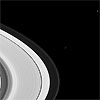
|
 |
Radio astronomers remove the blindfold
Oct
9:
U.K. radio astronomers at the Jodrell Bank Observatory, working with colleagues from
Europe and the U.S., have demonstrated a new technique that will revolutionise the
way they observe.
 FULL STORY FULL STORY
 |  |

|
 |
What is it? Mystery object discovered by astronomers
Oct
8:
Astronomers using the Gemini North and Keck II telescopes have peered inside a violent
binary star system to find that one of the interacting stars has lost so much mass to
its partner that it has regressed to a strange, inert body resembling no known star type.
 FULL STORY FULL STORY
 |  |

|
 |
Unravelling a 400-year-old supernova mystery
Oct
6:
Four hundred years ago, sky watchers, including the famous astronomer Johannes Kepler,
best known as the discoverer of the laws of planetary motion, were startled by the
sudden appearance of a "new star" in the western sky, rivaling the brilliance of the
nearby planets.
 FULL STORY FULL STORY
 |  |

|
 |
Satellite to seek nearest stars, brightest galaxies
Oct
6:
A new NASA mission, called the Wide-field Infrared Survey Explorer, will scan the
entire sky in infrared light in search of nearby cool stars, planetary construction
zones and the brightest galaxies in the universe.
 FULL STORY FULL STORY
 |  |

|
 |
Genesis samples go to JSC
Oct
6:
Following an extensive recovery effort since its September 8th impact at a Utah
landing site, the first scientific samples from the Genesis space probe arrived
at NASA's Johnson Space Center this week.
 FULL STORY FULL STORY
 |  |

|
 |
Frequent starbursts sterilize centre of Milky Way
Oct
5:
Life near the centre of our galaxy never had a chance. Every 20 million years
on average, gas pours into the galactic centre and slams together, creating
millions of new stars. The more massive stars soon go supernova, exploding
violently and blasting the surrounding space with enough energy to sterilize
it completely.
 FULL STORY FULL STORY
 |  |

|
 |
Giant 'pinhole camera' for exoplanet studies
Oct
1:
A NASA institute has selected a new University of Colorado at Boulder
proposal for further study that describes how existing technologies can
be used to study planets around distant stars with the help of an orbiting
"starshade."
 FULL STORY FULL STORY
 |  |

|
 |



